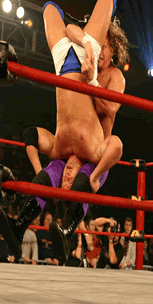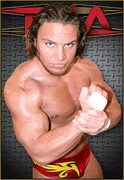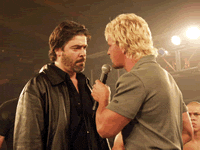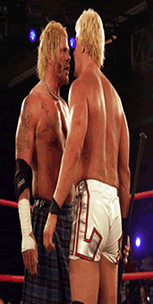Last month, PTTN started talking about the history of NWA:TNA, covering the build up to the first two weeks of pay-per-view for the company. I left you by mentioning that two factors gave TNA the identity it needed and pushed it into a new direction. In this, part two, I will talk about both of these, and the impact they had on TNA as a whole.
The first factor…
The first of the “main factors” was the X-division. An innovative idea unique to TNA, the X belt was worked around cruiserweight workers, although no weight level was ever placed onto it (as was shown later on in one of the X division’s darkest days). The point of the X Division was to provide fans with that one wrestling style that had been lost since WWE bought out WCW: cruiserweights. So TNA proceeded to make it’s own X Division roster.
Jerry Lynn was the former ECW World heavyweight champion and WWF Light heavyweight champion. His matches with Rob Van Dam were legendary, but even against other opponents, he was one of the most versatile and unselfish wrestlers in America. AJ Styles was an unknown sensation who had briefly worked with WCW before it died and the WWA. Whilst some didn’t look upon him highly, TNA showed a whole new side of the Phenomenal AJ. Low-ki had appeared at various Shotgun/Jakked/Metal tapings for the WWF and was very impressive with his super-stiff kicks and hard-edge look. TNA was the perfect place for the youngster to prove his worth to wrestling at a more competitive level. These three would be the rock from which the bungee of the X Division would be attached. One mistake, and the bungee would fall. It did anything but.
All three guys, with a supporting cast of such solid workers as Jimmy Yang, Psychosis, Elix Skipper and Christopher Daniels, carried the X Division to become one of the most well-loved titles in wrestling, a title defended in the most stunning and awe-inspiring matches seen in a good long while. The rest of the company wasn’t up to much, mind. But for at least a year, the X Division was THE division to watch.

AJ Styles became the first X-Division champion on the June 26th pay-per-view of 2002 (taped one week before in Huntsville, Alabama), only TNA’s second show. Last defeating Jerry Lynn in a double elimination match involving Low-ki and Psychosis, AJ raised TNA’s pride and joy in a match with Lynn considered the best televised match of 2002, and for good reason. In the weeks after, tension was built between AJ and Lynn, who were crowned Tag team champions in week 3. Week after week, the roles would reverse. One week, the tag titles would be on the line. The next, AJ and Lynn would be in singles matches. And whilst in tag team matches, other X-Division stars would be allowed to shine, keeping the belt fresh and people’s attentions up. Eventually, Lynn and AJ broke up, leading to a series of great matches, including a spectacular ladder match between Lynn, Styles, and Low-ki in week 11, which Lynn won, becoming the third X Division champion (Low-ki was the champion going into the match, having defeated Styles and Lynn in week 8).
Week after week, the title was kept as the focus of the product, even main eventing several pay-per-views. This wasn’t the WWE. Smaller guys were allowed to shine, and that was great news for one arriving Sean Waltman.
The former X-Pac came in as Syxx-Pac and proceeded to win the X-title against Styles, former F.B.I Tony Mamaluke, The SATs (Jose and Joel Maximo), former ECW Television champion Kid Kash & Ace Steele in a Battle Royal Ladder Match in week 15. The innovation was off the charts (although the influx of ladder matches proved to be a stumping block), and now the X title had a boost with a refreshed Waltman putting on blistering matches. As the year went on, the title swapped hands again, eventually ending up in the hands of Kid Kash, who proved to be one of it’s most successful champions, as a highly effective heel.
Unfortunately, it’s dark day was when the title ended up in the hands of, ironically enough, X. X was actually Pierre Oulette, formerly a Quebecer from the WWF with Jacques “The Mountie” Rougeau. The big tough veteran was a great worker back in the mid nineties, but was a shadow of himself by now. Why he was brought in baffles me to this day, but he decimated the X division, squashing everyone in his path. Luckily, the experiment didn’t last long, and he was soon gone. But those few weeks of X in control certainly aren’t the days of the X division that I want to remember.

These days, with AJ Styles now a former World champion and regularly main eventing, Waltman out of the company, and Low-ki appearing sparingly, the title rests around the new breed. At the top is arguably the biggest new star created by the division: Chris Sabin. Supporting him is X veteran Lynn, Frankie Kazarian, Michael Shane (the nephew of Shawn Michaels), Amazing Red and Elix Skipper. And now they have a new toy to play with, in America’s X Cup, where teams from around the world come to fight for the cup. The current champions are Team Mexico, featuring Juventud Guerrera and Mr Aguila (formerly Essa Rios and Papi Chulo). Other teams include Team USA, Team Canada and Team UK, with a Team Japan in the works.
For now, the X title may have seen better days, but it’s seen a hell of a lot worse too. In fact, some may say that the X division is very strong at the moment, and the only reason it’s not as big a focus as before is because the rest of the company has got it’s act together. It’s very plausible, and no matter the reason, the X title is still going strong, and will do for a very long time to come.
The Second factor…
The second factor is one I’d never imagine myself saying. It’s a controversial subject and one that provokes so many differing opinions, it’s unbelievable. But then, that may be why it was one big success for TNA. Ladies and gentlemen, your second factor: Vince Russo.
The backstory on Russo is simple. The New York resident started out as a Radio DJ, talking wrestling until WWF paid him off to promote them, eventually landing a job with them as Editor of their magazines. Under the guise Vic Venom, Russo would write controversial and scathing columns, pushing the envelope as far as possible. He started attending booking meetings to know how to plan the magazine accordingly, and ended up with a job on the booking team. He and McMahon worked together in creating the “Attitude” era, and credits himself with making WWF millions of dollars (a fact as yet unproved, as Russo was not the sole booker, and created as many bad ideas as he did good). His theory was then somewhat disproved when he took a job in WCW and was given the solo pen. He proceeded to help kill WCW, and then left as the company sank to it’s doom. Many felt that hiring Russo was a bad idea for TNA, but afterall, he was Jeff Jarrett’s buddy, so we couldn’t really do anything about it.
So in early July 2002, Russo was aboard. And to be fair, the changes weren’t seen immediately. But as the months strolled along, fans started to notice changes. Alan “Kwee-Wee” Funk was thrown in as Bruce and did the old Andy Kaufman deal, fighting girls. Obviously, at this point, fans weren’t looking optimistically at the fledging promotion. Things got worse when B.G “Roaddogg” James signed for the group, looking more worn down than ever (and to be fair, he hadn’t really cared about the business since Owen Hart’s death), and the late Curt Hennig was brought in, for no other reason than name value, seemingly. When The Dupps were left fighting Ed Ferrera, you just knew things were only going to get worse.
But, as it happened, it didn’t turn out that bad at all. TNA created it’s first new star in Ron “The Truth” Killings, formerly K-Kwik of the WWF. And at long last, Russo debuted on TNA pay-per-view, under the mask of Mr Wrestling III. Now, as an on-screen character in WCW, he was never really praised. Myself personally, I didn’t mind him. I thought that when he wasn’t talking to the smart crowd, he came off well. But on a lower-scale level, he actually came off even better. People bought him as the “antichrist” of wrestling, and they used it to amazing effect.
First, they capitalised on his real life heel status stemming from making David Arquette the WCW world champion (incidentally, it was actually Tony Schiavone who came up with that idea, not Russo). Putting him in a feud with Mike Tenay, the two had heated discussions that not only made Russo out to be callous and ruthless, but also capitalised on just how smart Tenay really was. Everyone knows that Mike Tenay is probably the best all-round commentator in the US today, and TNA did a great job of making us see that.
Secondly, he made his own stable. Now, there were a few stables around at the time, but none that could be taken as a serious threat, and usually all the big storylines in wrestling come from stables. The nWo, D-Generation X, The Four Horsemen (all 1 million incarnations of them), The Hart Foundation, The Dangerous Alliance, I could go on and on. They all had immense impacts on wrestling. Now, as a lower league company, of course this stable wasn’t going to set the world on fire. But it did provide new babyface champion Jeff Jarrett with a legitimate challenge. See, Russo brought in his boys at Sports Entertainment Xtreme (or SEX… gotta love Russo). As stupid a name as it may be, it provided the perfect catalyst for TNA. it would be SEX against the tradition of NWA, and on paper, was an excellent feud.

As the gang grew, Russo told Jarrett to make a choice… with him or against him. Jarrett naturally chose against, and took out SEX. This led to weeks of Russo continually beating Jarrett with belts and stable beatings. At one point, Russo even managed to create enough stir for SEX by destroying the old TNA logo which set the scene for a new logo and entrance way (the former which is still used now, the latter which changed as soon as AJ Styles became World champion). Indeed, Russo was now an all-seeing, all-powerful heel magnet with a stable of merry confidants, all with the same goal – take out the champion. Good way to get the champion and the faces around him over, but in particular, the champion (perfect booking sense – afterall, the champion should be the focus of every show).
Booking wise, Russo wasn’t doing too bad either. For a small period of time, they instituted a weekly “Surprise Guest” to gain interest for the product. The guests included Dusty Rhodes, Roddy Piper, Vader, and The Road Warriors (better known as the Legion of Doom, Animal and the late Hawk). They didn’t get put over on most occasions (except for Dusty who stuck around for quite a long period of time), and for the most part, helped get the younger guys over. One team in particular who Russo pushed this way were Triple X, comprising of “Fallen Angel” Christopher Daniels, Low-ki, and “Prime Time” Elix Skipper, an extremely athletic young man who Russo bought up from the WCW Power Plant in 2000 to be part of Lance Storm’s “Team Canada”. For all his problems, Russo always maintains that the youth should be pushed, and all the credit in the world to him, he did his best to get teams like Triple X and America’s Most Wanted (“Wildcat” Chris Harris and “Cowboy” James Storm) over. Kid Kash was another who was pushed strongly, and for the most part, carried himself incredibly well as a heel, after spending his ECW tenture as babyface.

Things got even stronger when Raven was bought in. The man known to his friends as Scott Levy had just been released from the WWE and was ready to unleash himself on the TNA fans. An intellectual guy, Raven managed to get himself booking influence, through his friendship with Russo and Glenn “Disco Inferno” Gilberti, who himself managed to gain a piece of the pen. Raven was booked as the masterplan of SEX, with Julio Dinero and Alexis Laree at his side. It all led to the infamous Jarrett/Raven showdown, which many still consider to be the biggest night in TNA history. The booking of the match itself was excellent, but as the match ended, so did Russo’s involvement with the company for a while. For you see, Russo and Jarrett weren’t getting along that well. Russo wanted more power, and Jarrett wanted more power. The ending result was Russo left as a on-screen performer only. He spent time with AJ Styles, as the SEX faction faded out, and then left again, only to return recently as the new Director of Authority, looking better than he ever has.
His tenture in TNA has been rocky. But to think that before he arrived, TNA was just matches and nothing more, before evolving into the set-up to the biggest feud and match in TNA’s two years, I think Russo did TNA a lot of good.
Next time…
I’ll talk you through the buyout, and the overall effects, positive and negative, on TNA.
